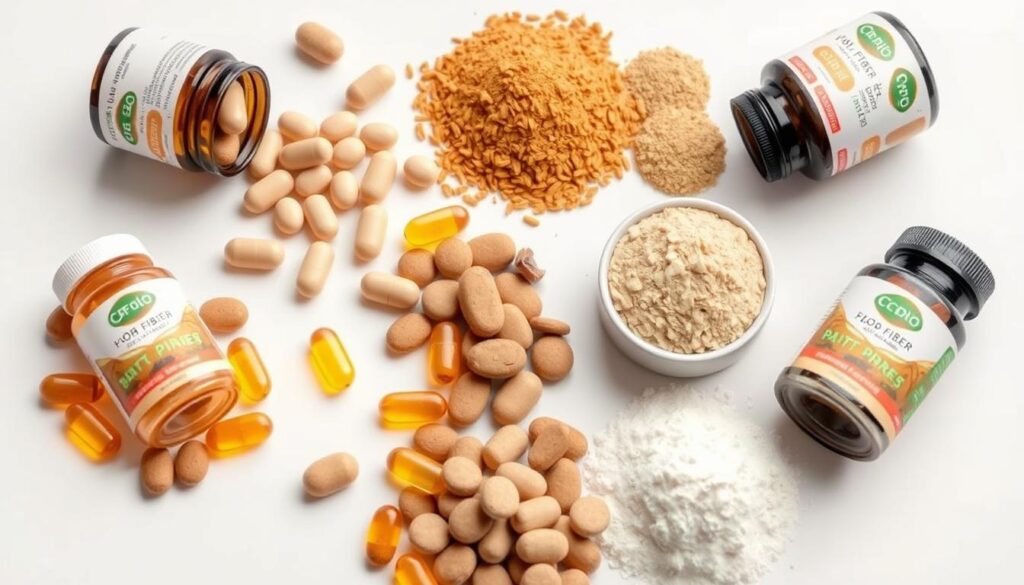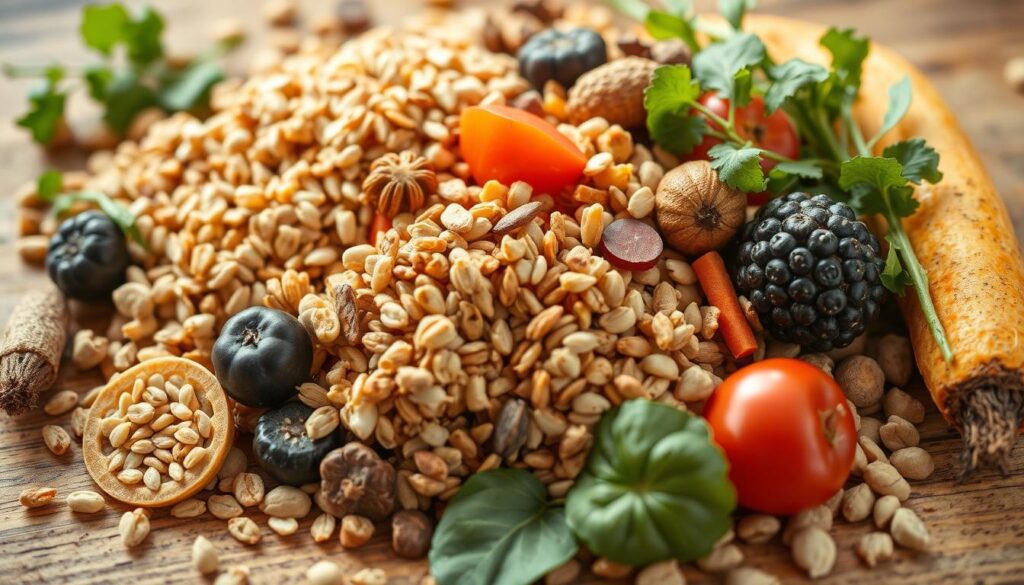High Fiber Foods for Dogs: Love Their Belly, Naturally
Table of Contents
Every dog parent knows that moment of worry when your furry friend experiences digestive discomfort. I remember watching my rescue dog, Max, struggle with irregular bowel movements and feeling helpless. That’s when I discovered the transformative power of high fiber foods for dogs. Proper nutrition isn’t just about filling their bowl—it’s about supporting their overall digestive health and well-being.
Dog digestion is a complex system that requires careful nutritional balance. Incorporating the right high fiber foods can make a significant difference in your dog’s comfort, energy levels, and long-term health. From supporting gut microbiome to maintaining healthy weight, fiber plays a crucial role in your dog’s nutritional landscape.
Understanding how to effectively integrate fiber into your dog’s diet can seem challenging, but with the right knowledge, you can help your canine companion thrive. This guide will walk you through everything you need to know about nourishing your dog with fiber-rich foods that support optimal digestive function.
Key Takeaways
- Fiber is essential for maintaining healthy dog digestion
- Different types of fiber offer unique health benefits
- Natural fiber sources can improve overall canine wellness
- Proper fiber intake supports weight management
- Digestive health impacts your dog’s entire body system
Understanding the Role of Fiber in Canine Health
Fiber is key for your dog’s health and digestion. Just like us, dogs need the right amount of fiber. It keeps their digestive system working well and helps them stay healthy.
Learning about dog digestion is important. It shows how different fibers affect a dog’s body. Fiber is more than just a simple nutrient. It plays a big role in many areas of a dog’s health.
Types of Dietary Fiber for Dogs
Dogs have two main types of fiber:
- Soluble Fiber: Dissolves in water and helps control blood sugar
- Insoluble Fiber: Makes stool bulkier and helps with smooth bowel movements
Benefits of Fiber for Dog Digestion
Fiber is great for your dog’s digestion. It helps with weight management, keeps bowel movements regular, and supports good gut bacteria.
How Fiber Supports Gut Health
Fiber keeps your dog’s gut healthy. It helps prevent digestive problems and boosts their immune system. By managing fiber, you can avoid digestive issues and improve your pet’s health.
Fiber is not just about quantity, but quality and balance in your dog’s diet.
High Fiber Foods for Dogs: Natural Sources
Looking for natural high fiber foods for dogs can really help their digestion. Many pet owners forget how important fiber-rich dog treats are. Luckily, there are many healthy options to boost your dog’s diet.
Dogs need plant-based fiber to keep their digestive system healthy. These foods give them important nutrients and help their gut stay in top shape.
- Pumpkin: A powerhouse of fiber, pumpkin helps regulate digestion and provides essential nutrients
- Green beans: Low-calorie and packed with fiber, perfect for weight management
- Sweet potatoes: Rich in vitamins and dietary fiber
- Carrots: Crunchy treats that support digestive health
- Apples (without seeds): Natural fiber source with added vitamins
Start with small amounts of high fiber foods for dogs. Watch how they react. Every dog’s gut is different, so adding fiber slowly is best to avoid upset stomachs.
Try making homemade fiber-rich dog treats with these ingredients. Steamed veggies or pureed pumpkin are great for their diet. Always talk to your vet to make sure your dog gets the right mix of nutrients.
The Science Behind Canine Fiber Requirements
Knowing what your dog needs to stay healthy is key. Fiber is important for their digestive system and overall health. As dogs grow, their diet needs change, so it’s important to adjust their food.
Experts say adding more fiber to a dog’s diet can greatly improve their health. The right amount helps with digestion, weight control, and supports the body in many ways.
Daily Fiber Intake Guidelines
Your dog’s fiber needs depend on several things:
- Age of the dog
- Body weight
- Overall health condition
- Activity level
Vets usually suggest:
- Puppies: 1-2% fiber in their diet
- Adult dogs: 2-4% fiber
- Senior dogs: 3-5% fiber
Signs of Fiber Deficiency
Look out for these signs of not enough fiber:
- Irregular bowel movements
- Constipation
- Unexpected weight gain
- Reduced energy levels
Optimal Fiber Levels by Age and Size
Different dogs need different amounts of fiber. Small dogs might need less, while big dogs often need more to keep their digestive system healthy.
Talking to your vet is the best way to figure out how much fiber your dog needs.
Incorporating Fiber-Rich Foods into Your Dog’s Diet
Adding fiber to your dog’s diet needs a careful plan. Their health depends on slow and smart changes. Start by learning how to add fiber-rich foods safely and well.
Here are key steps to add more fiber to your dog’s diet:
- Start with small amounts of fiber-rich foods
- Watch how your dog’s stomach reacts
- Talk to your vet before big diet changes
- Pick high-quality, natural fiber sources
Making homemade treats with fiber is a great way to improve your pet’s diet. Pumpkin, sweet potato, and green beans are great natural choices that dogs love.
| Fiber Source | Serving Size | Benefits |
|---|---|---|
| Pumpkin | 1-2 tablespoons | Supports digestive health |
| Sweet Potato | Small cubes | Rich in nutrients |
| Green Beans | Chopped, steamed | Low-calorie fiber |
For dogs with sensitive stomachs, add fiber-rich treats slowly. Start with a little and increase it over time. Watch for any signs of upset stomach and adjust as needed.
Remember: Balance is key in your dog’s nutrition journey.
By focusing on fiber intake, you can greatly improve your dog’s digestive health and life quality.
Commercial High-Fiber Dog Food Options
Finding the best high fiber dog food can be tough. Knowing about commercial dog food helps you choose well for your dog. There are many pet foods with added fiber that help with digestion.
Looking at commercial dog foods needs careful label reading and knowing brands. Your dog’s specific needs will help you pick the right food.
Reading Dog Food Labels
When looking for high-fiber foods, watch for these important labels:
- Total fiber percentage
- Fiber sources
- Recommended serving sizes
- Nutritional adequacy statement
Top Brands for Fiber Content
Many trusted brands have great high-fiber dog food:
| Brand | Fiber Content | Primary Fiber Sources |
|---|---|---|
| Royal Canin Digestive Care | 4.1% | Beet pulp, rice bran |
| Hill’s Science Diet | 3.5% | Whole grain wheat, soybean mill run |
| Purina Pro Plan Focus | 3.8% | Wheat bran, chicory root |
Prescription vs. Over-the-Counter Options
Understanding the difference between prescription and standard high fiber dog food is key:
- Prescription foods: Made for specific health needs
- Over-the-counter foods: General digestive support
- Get vet advice for special diets
Choosing the right fiber-rich pet food depends on your dog’s health needs and vet advice.
Safe Fiber Supplements for Dogs

Choosing the right soluble fiber for dogs can be a game-changer in your pet’s digestive health. Fiber supplements offer a targeted approach to supporting your dog’s nutritional needs when diet alone isn’t enough.
Dogs can benefit from carefully selected fiber supplements that provide both soluble and insoluble fiber sources. These supplements come in various forms, each designed to address specific digestive concerns:
- Psyllium husk powder: A popular soluble fiber supplement
- Wheat bran: An excellent insoluble fiber source
- Pumpkin powder: Natural fiber with added nutritional benefits
- Prebiotic fiber blends: Specifically formulated for canine digestive support
Important: Always consult your veterinarian before introducing any new supplement to your dog’s diet. The right dosage depends on your dog’s size, age, and specific health conditions.
“Fiber supplements can be a powerful tool in managing your dog’s digestive health when used correctly.” – Veterinary Nutrition Experts
When selecting a fiber supplement, consider these key factors:
- Your dog’s specific digestive needs
- Potential interactions with existing medications
- Quality and purity of the supplement
- Recommended dosage for your dog’s weight
Insoluble fiber sources like wheat bran can help regulate bowel movements, while soluble fiber for dogs supports overall gut health and can help manage weight. Start with small amounts and monitor your dog’s response carefully.
Potential Risks and Considerations
Canine dietary fiber is great for health, but too much can be bad. It can mess with your dog’s digestion if not balanced right.
Feeding your dog too much fiber can cause serious problems:
- Nutrient absorption interference
- Unexpected weight loss
- Coat quality deterioration
- Gastrointestinal complications
Too much insoluble fiber can create substantial digestive challenges for your furry friend. Dogs need a diet that’s balanced for their digestion.
“Balance is key when introducing fiber into your dog’s nutritional plan.” – Veterinary Nutrition Experts
Look out for signs your dog might be eating too much fiber, like:
- Persistent diarrhea
- Frequent vomiting
- Reduced appetite
- Unusual lethargy
Talking to a vet can help find the right amount of fiber for your dog. This keeps their digestion healthy.
Special Dietary Needs and Fiber Integration
Dogs have special nutritional needs that can be met with the right diet. High fiber foods are key for addressing health concerns at all life stages and conditions.

Dogs don’t all need the same food. Learning how to increase fiber in their diet can greatly improve their health.
Weight Management Programs
Fiber is a big help for overweight dogs. It makes them feel full, which aids in weight loss:
- Reduces calorie consumption
- Increases satiety between meals
- Supports metabolic health
Senior Dog Requirements
Older dogs have unique nutritional needs. Carefully selected high fiber foods for dogs help with digestive issues:
- Improves nutrient absorption
- Supports consistent bowel movements
- Helps maintain healthy gut bacteria
Digestive Issue Solutions
Increasing fiber in a dog’s diet can solve many digestive problems. Vets often suggest specific fiber plans for issues like constipation or irregular bowel movements.
Always consult with your veterinarian before making significant dietary changes for your dog.
Conclusion
Optimal dog digestion starts with knowing the importance of high fiber foods. Your dog’s diet is more than just filling a bowl. It’s about giving them a balanced diet that supports their health.
By choosing fiber-rich foods, you can help your dog’s digestive system stay healthy. This improves their quality of life.
Veterinarians stress the need for proper fiber intake. You can pick natural sources like pumpkin and sweet potatoes or go for specialized dog foods. The goal is to find the right balance for your pet’s needs.
Every dog is unique, so it’s important to consult with a vet. They can help you choose the best fiber options for your dog.
Adding high fiber foods to your dog’s diet isn’t a one-size-fits-all solution. Age, size, and health conditions affect the right amount of fiber. Watch how your dog reacts to new foods and adjust as needed.
With the right care and guidance, you can support your dog’s digestive health. This ensures they stay healthy and happy.
Your dedication to understanding dog digestion and nutrition is key. By focusing on fiber-rich foods and staying informed, you’re giving your dog the best care.
FAQ
How much fiber does my dog really need daily?
Dogs need about 2-4% of their diet to be fiber. This depends on their age, size, and health. For most dogs, this means 1-2 grams of fiber per 10 pounds of body weight. Always check with your vet to find the right amount for your dog.
What are the best natural high-fiber foods for dogs?
Great natural fiber foods for dogs include pumpkin, sweet potatoes, and green beans. Carrots, apples (without seeds), and brown rice are also good. These foods add fiber and nutrients. Start with small amounts to avoid upset stomachs.
Can too much fiber be harmful to my dog?
Yes, too much fiber can upset your dog’s stomach. It can cause bloating, gas, diarrhea, and make it hard for them to absorb nutrients. Watch for signs like loose stools and a decrease in appetite. It’s important to find the right balance.
Are fiber supplements safe for dogs?
Fiber supplements like psyllium husk can be safe if used right and with vet advice. They help with digestion and weight control. But, always follow the dosage and talk to your vet before adding them to your dog’s diet.
How can fiber help with my dog’s weight management?
Fiber makes dogs feel full, which can lower calorie intake. High-fiber foods help them eat less and feel satisfied. This can help with weight loss while keeping them healthy.
Do senior dogs have different fiber requirements?
Yes, senior dogs need adjusted fiber intake. As they age, their metabolism slows, and they may eat less. More fiber helps with digestion, weight, and overall health. They might need a diet with easy-to-digest fiber.
How do I know if my dog needs more fiber?
Signs your dog needs more fiber include constipation and irregular bowel movements. They might strain when they poop or have hard stools. A vet can help figure out if your dog needs more fiber.
Can I make homemade high-fiber dog treats?
Yes, you can make fiber-rich treats at home. Use pumpkin, sweet potato, and brown rice. Try baking sweet potato chips or making pumpkin biscuits. Make sure the ingredients are safe for dogs and introduce them slowly.
There are no reviews yet. Be the first one to write one.


